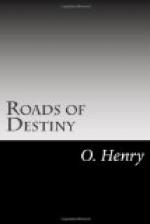And so, before the great picture by the door of the chamber of representatives at frequent times for many days could be found the breezy, robust form of Senator Kinney and be heard his clarion voice reciting the past deeds of Lucien Briscoe in connection with the handiwork of his grandson. Senator Mullens’s work was more subdued in sight and sound, but directed along identical lines.
Then, as the day for the introduction of the bill for appropriation draws nigh, up from the San Saba country rides Lonny Briscoe and a loyal lobby of cowpunchers, bronco-back, to boost the cause of art and glorify the name of friendship, for Lonny is one of them, a knight of stirrup and chaparreras, as handy with the lariat and .45 as he is with brush and palette.
On a March afternoon the lobby dashed, with a whoop, into town. The cowpunchers had adjusted their garb suitably from that prescribed for the range to the more conventional requirements of town. They had conceded their leather chaparreras and transferred their six-shooters and belts from their persons to the horns of their saddles. Among them rode Lonny, a youth of twenty-three, brown, solemn-faced, ingenuous, bowlegged, reticent, bestriding Hot Tamales, the most sagacious cow pony west of the Mississippi. Senator Mullens had informed him of the bright prospects of the situation; had even mentioned—so great was his confidence in the capable Kinney—the price that the state would, in all likelihood, pay. It seemed to Lonny that fame and fortune were in his hands. Certainly, a spark of the divine fire was in the little brown centaur’s breast, for he was counting the two thousand dollars as but a means to future development of his talent. Some day he would paint a picture even greater than this—one, say, twelve feet by twenty, full of scope and atmosphere and action.
During the three days that yet intervened before the coming of the date fixed for the introduction of the bill, the centaur lobby did valiant service. Coatless, spurred, weather-tanned, full of enthusiasm expressed in bizarre terms, they loafed in front of the painting with tireless zeal. Reasoning not unshrewdly, they estimated that their comments upon its fidelity to nature would be received as expert evidence. Loudly they praised the skill of the painter whenever there were ears near to which such evidence might be profitably addressed. Lem Perry, the leader of the claque, had a somewhat set speech, being uninventive in the construction of new phrases.
“Look at that two-year-old, now,” he would say, waving a cinnamon-brown hand toward the salient point of the picture. “Why, dang my hide, the critter’s alive. I can jest hear him, ‘lumpety-lump,’ a-cuttin’ away from the herd, pretendin’ he’s skeered. He’s a mean scamp, that there steer. Look at his eyes a-wallin’ and his tail a-wavin’. He’s true and nat’ral to life. He’s jest hankerin’ fur a cow pony to round him up and send him scootin’ back to the bunch. Dang my hide! jest look at that tail of his’n a-wavin’. Never knowed a steer to wave his tail any other way, dang my hide ef I did.”




